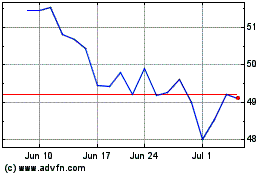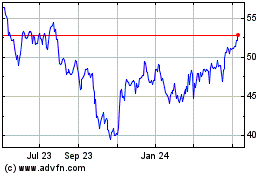OPEC's Oil Production Cut in Doubt as Output Flows
November 11 2016 - 7:30AM
Dow Jones News
LONDON—The Organization of the Petroleum Exporting Countries
pumped more crude oil last month even as the group geared up to
complete a plan to cut output at its meeting at the end of this
month in an effort to stabilize oil prices.
OPEC's crude oil output increased by 240,000 barrels a day in
October to 33.64 million barrels a day, the group said in its
monthly oil market report Friday, with Nigeria, Libya and Iraq
driving the supply boost.
OPEC's October production is now well in excess of the high-end
of the output range the group agreed to at a meeting in Algiers in
September, highlighting the challenge members will face
implementing that deal at its next meeting in Nov. 30 in Vienna.
According to the report, the group was pumping almost 1 million
barrels a day more than what is expects demand for its crude to be
next year.
The countries driving the bulk of the increase—Nigeria, Libya
and Iraq—are those seeking exemptions from the cut.
Without a cut, the world's oil stockpiles are likely to keep
building, putting further pressure on oil prices, which are still
trading below $50 a barrel, down from the more than $100 levels
seen in mid-2014.
"Looking ahead, it is important to consider the immediate impact
that the assumed global supply/demand balance has on inventories,
given the expected demand for OPEC crude in 2017 of 32.7 million
barrels a day," OPEC said in its report.
"Adjustments in both OPEC and non-OPEC supply will accelerate
the drawdown of the existing substantial overhang in global oil
stocks and help bring forward the rebalancing of the market," the
report said.
OPEC's task of trimming global oil supplies is further
challenged by producers outside the cartel, such as Russia, Brazil,
Canada and Kazakhstan, which are also ramping up the amount they
produce.
The potential for increased oil supplies comes as OPEC kept its
outlook for world oil demand growth next year unchanged at 1.15
million b/d as economic activity has been muted, despite the more
than two-year slump in oil prices.
The collapse in oil prices from over $100 a barrel in mid-2014
to below $50 currently has roiled the oil sector, forcing companies
to cut spending and jobs and hammering the economies of OPEC
producers, notably Venezuela, that rely on oil revenues.
Write to Selina Williams at selina.williams@wsj.com
(END) Dow Jones Newswires
November 11, 2016 07:15 ET (12:15 GMT)
Copyright (c) 2016 Dow Jones & Company, Inc.
Dominion Energy (NYSE:D)
Historical Stock Chart
From Mar 2024 to Apr 2024

Dominion Energy (NYSE:D)
Historical Stock Chart
From Apr 2023 to Apr 2024
